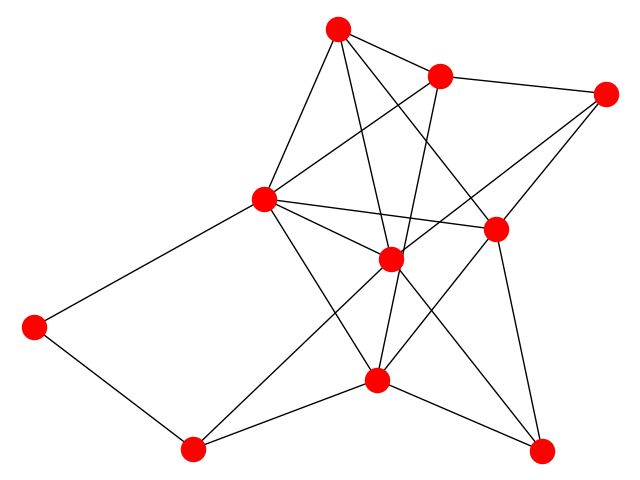Erdos Renyi¶
Create an G{n,m} random graph with n nodes and m edges and report some properties.
This graph is sometimes called the Erdős-Rényi graph but is different from G{n,p} or binomial_graph which is also sometimes called the Erdős-Rényi graph.

Out:
node degree clustering
0 6 0.333333
1 3 0.333333
2 4 0.500000
3 4 0.333333
4 2 0.000000
5 5 0.300000
6 5 0.100000
7 3 0.000000
8 3 0.000000
9 5 0.300000
#/home/travis/build/networkx/networkx/examples/graph/plot_erdos_renyi.py
# GMT Mon Jan 22 07:35:58 2018
#
0 2 3 4 5 6 9
1 9 5 6
2 3 5 6
3 8 9
4 7
5 8 9
6 8 7
7 9
8
9
# Author: Aric Hagberg (hagberg@lanl.gov)
# Copyright (C) 2004-2018 by
# Aric Hagberg <hagberg@lanl.gov>
# Dan Schult <dschult@colgate.edu>
# Pieter Swart <swart@lanl.gov>
# All rights reserved.
# BSD license.
import sys
import matplotlib.pyplot as plt
from networkx import nx
n = 10 # 10 nodes
m = 20 # 20 edges
G = nx.gnm_random_graph(n, m)
# some properties
print("node degree clustering")
for v in nx.nodes(G):
print('%s %d %f' % (v, nx.degree(G, v), nx.clustering(G, v)))
# print the adjacency list to terminal
try:
nx.write_adjlist(G, sys.stdout)
except TypeError: # Python 3.x
nx.write_adjlist(G, sys.stdout.buffer)
nx.draw(G)
plt.show()
Total running time of the script: ( 0 minutes 0.058 seconds)